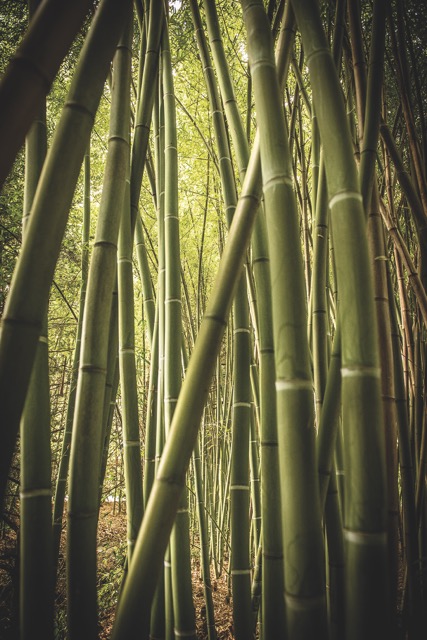The Bamboo Grove
The English garden is designed like a mosaic of species, each with its own botanical, cultural, and symbolic identity.
The Castle Park invites you on a journey across continents with yews and boxwoods from Europe, bald cypresses and sequoias from America, and camellias from China.
At the edge of the ancient entrance avenue, the sound of water flowing through irrigation channels seems to draw us toward the grove of giant bamboo which is as intricate as a labyrinth. The visual dimension, which directs our gaze upward along the reeds and nodes, merges with the auditory one. Light struggles to filter through, while the wind and birdsong evoke the landscapes of Hiroshige, the landscape artist who inspired Monet, and whose woodblock prints harmonize lyricism, serenity, and idealism with nostalgia.
Bamboo is an evergreen plant native to China. It grows spontaneously and, thanks to its root system, prevents soil erosion. In late spring, new shoots emerge from the ground and, during this season, can grow up to 20 cm per day. The plants have hollow yet highly durable stems, often used in China and Japan for building construction scaffolding.
Bamboo carries numerous symbolic references across different cultures and eras.
In Chinese society its elegant appearance symbolized the ideal behaviour of a gentlemen who, like this plant, should always remain upright and strong. Just as the bamboo stalk is hollow, a gentleman should maintain an open mind, free from prejudice or hidden thoughts.
In various Asian cultures, it is believed that humanity originated from a bamboo stalk. In Filipino mythology, legend says that the first man and woman were freed from the opening of a bamboo shoot, which emerged on an island created after the battle between the elemental forces of Sky and Ocean.

The English garden is designed like a mosaic of species, each with its own botanical, cultural, and symbolic identity.
The Castle Park invites you on a journey across continents with yews and boxwoods from Europe, bald cypresses and sequoias from America, and camellias from China.
At the edge of the ancient entrance avenue, the sound of water flowing through irrigation channels seems to draw us toward the grove of giant bamboo which is as intricate as a labyrinth. The visual dimension, which directs our gaze upward along the reeds and nodes, merges with the auditory one. Light struggles to filter through, while the wind and birdsong evoke the landscapes of Hiroshige, the landscape artist who inspired Monet, and whose woodblock prints harmonize lyricism, serenity, and idealism with nostalgia.
Bamboo is an evergreen plant native to China. It grows spontaneously and, thanks to its root system, prevents soil erosion. In late spring, new shoots emerge from the ground and, during this season, can grow up to 20 cm per day. The plants have hollow yet highly durable stems, often used in China and Japan for building construction scaffolding.
Bamboo carries numerous symbolic references across different cultures and eras.
In Chinese society its elegant appearance symbolized the ideal behaviour of a gentlemen who, like this plant, should always remain upright and strong. Just as the bamboo stalk is hollow, a gentleman should maintain an open mind, free from prejudice or hidden thoughts.
In various Asian cultures, it is believed that humanity originated from a bamboo stalk. In Filipino mythology, legend says that the first man and woman were freed from the opening of a bamboo shoot, which emerged on an island created after the battle between the elemental forces of Sky and Ocean.
Audio

